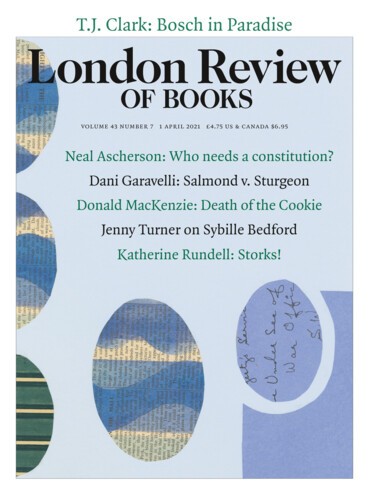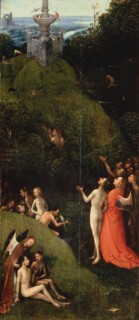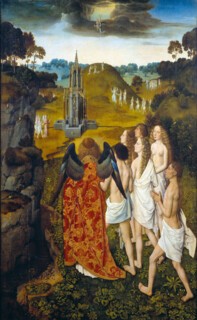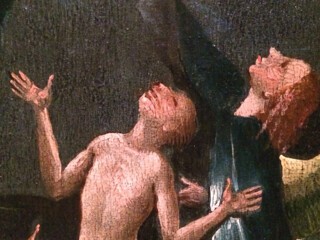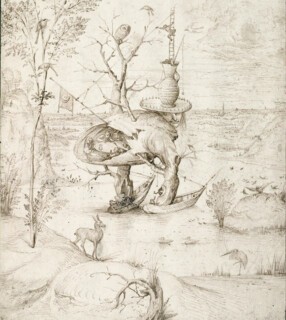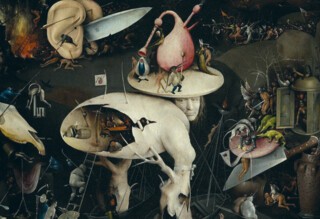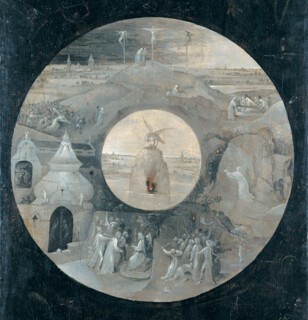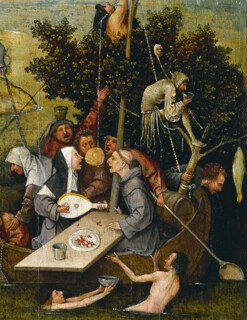We are on our way to Paradise. Some say we are there already; and it is true that the soft green hill the angels are leading us towards, and the fountain perched on top with its retinue of birds, could well be a Garden of Eden. The angels are forbearing: they know we’re likely to make a slow start. Some of us look to have registered the new light in the sky, and are caught between an eagerness to go onwards and fear or perhaps puzzlement. An angel in red stands next to me. The crowd on the other side of the angel appear to be simple folk – I’m not priding myself on my tonsure and Roman nose – but they too are focused on the light from above. One of them lunges skyward with a theologian’s arm, explaining to the flock. All this group are erect. Others, a little way off on the grass, are seated, as if not ready to move on – perhaps not interested. I myself have no memory of having just exited from the earth. (Uprightness is my natural element. I stand tiptoe on two small feet.) But it could be, nonetheless, that this is the beginning of the Last Judgment, and that the man and his attentive wife nearby, being looked after by another angel, are barely out of the grave. The man too seems to be explaining things, or maybe registering and reiterating a point the angel has just made. I do not understand the conduct of the others. A man to my left is absorbed in conversation with a grey and white bird. It looks as if he is instructing the creature – his fingers, like those of the rough theologian, are didactic. Are we at the moment in God’s scheme when the children of Adam teach the animals the names of things? Or is the man taking lessons from the bird? The birds on the fountain have a better view of the sky.
I do not understand, and cannot wholly approve. A man beyond the bird-teacher strikes me as reaching out towards a woman too eagerly – he touches her forearm. Another has a tonsure like mine and seems to be expounding a truth to another group mostly in deep shadow. I don’t trust the truth or the group. In among the trees at the foot of the hill I catch a glimpse of a further party, naked, one of them a woman with long hair gathered in a jewelled pin. Is this Eden? Over in the darkness to the right of the hill is what appears to be a lion devouring its prey. The fountain, with its Donatello cherubs at the corners, clearly speaks to a past – a sophistication – from which we have fallen. Thank God.
So much for the view of the man with the tonsure. Obviously it is a device, and not without dangers, to put the particulars and uncertainties of Bosch’s panel into the mind of one of its protagonists. But it is not a device – it is a necessity, and one almost universally unrecognised by those who write about the artist – to insist on the particulars and to see that they are meant to generate doubts. (To generate dialectic, one might say – the kind consuming the man with the bird.) The painting in question – let’s call it Terrestrial Paradise – is one of four panels, oil on wood, now in the Accademia in Venice. The shape of the panels is crucial. Each is 35 inches high and a little short of 16 inches wide; originally they may have been a few inches taller top and bottom. The tallness and narrowness seem meant to amplify the idea of elevation in panels one and two – Terrestrial Paradise is followed by a scene in which the elect are lofted, almost sucked, into a kind of celestial test tube – but the panels, especially when seen together, are constricted enough to seem like prison cells. The size of the figures within the frame confirms this. Darkness predominates as you move from left to right. (The order of the panels as we see them now is conjectural, but surely makes sense.) Falling may be the truth of things. The way the pose of the despairing man in Hell half-mimics that of the husband on the grass in Paradise is cruel.
Were the four panels always meant to go together? The painted decoration on the back of the oak suggests as much. Were they the wings of an altarpiece? Perhaps. A four-part polyptych is an oddity, especially with panels so large. But oddity and Bosch go together. Why are the panels in Italy? They seem to have belonged early on to a cardinal named Domenico Grimani. Whether he commissioned them from Bosch – whether Bosch ever went to Italy – is unknown. They could have been bought on the open market: Bosch soon became an international property. What the panels depicted was clear, or roughly so (with the accent on roughly). One connoisseur in the 1520s, visiting the cardinal’s collection, produced the title La tela de lo inferno. He called a companion piece La tela de li sogni. Why only two out of four pictures are mentioned is a puzzle. An 18th-century guidebook settles for ‘four panels with hybrid animals and scenes of witchcraft’.
Compare Terrestrial Paradise with a painting on the same subject by Dieric Bouts. It is a fair comparison: the Bouts seems to have been one wing of a Last Judgment done for a church in Louvain in 1468, and Louvain is sixty miles south of Bosch’s hometown, ’s-Hertogenbosch: Bosch could well have seen the Bouts in situ. The painting would already have seemed a little old-fashioned by the time Bosch recollected it – let’s assume Bosch’s Paradise was painted in the very early years of the 16th century – but he would certainly have admired its treatment of the subject. You feel sometimes that Bouts is being deliberately cited – in the robed angel seen from behind, the confident male towards the right, the fountain, the birds on the cliff, even (in panel two in Venice) the hole through the clouds to heaven. And no doubt both artists were partly repeating prototypes that have not come down to us.
What marks the Bosch off from the Bouts is obvious. It’s only necessary to labour the comparison because a majority of art historians are so anxious to see no fundamental difference between the one Paradise and the other; between the kind of artist Dieric Bouts was, the kinds of artistic expectations he catered to, and the kind of artist who made La tela de li sogni. The latter remains a mystery. The ‘documents’ don’t help. They paint a picture of a provider of visual services whose ordinariness, as a member of ’s-Hertogenbosch society, guaranteed that the few – very few – traces he left in the record are impeccable in their banality. The highest moments in his professional life appear to be his selection, more than once, as host of a swan dinner for the Brotherhood of Our Blessed Lady. Useful basic networking. Father and grandfather had been Brothers before him. Painting was the family business: eleven men called Bosch, through five generations, are titled ‘painters’ in the archive. We have a single surviving contract for a major work, from the period round 1500 when Hieronymus had grown into a force to be reckoned with – a Last Judgment commissioned by Philip the Fair. The work no longer exists. In the case of all Bosch’s surviving masterpieces – the Haywain and Adoration of the Magi in Madrid, the versions of The Temptation of Saint Anthony, the Vienna Last Judgment and, of course, the Pintura de la variedad del mundo, que llaman del Madroño (the Garden of Unearthly Delights) – we have no idea about initial commissions, let alone about the patron’s requirements and emphases. Or rather, we have ideas in plenty – most scholars fall over themselves in eagerness to have the Garden be a piece ordered specially by the Duke of Nassau, even though the first mention of it in his possession occurs probably a good twenty years after it was painted – but proofs there are none.
Look again at Paradise with the Bouts alongside it. One thing is clear. Whoever it was first took possession of Bosch’s picture – whether they signed a contract or bought it from a dealer – must have known perfectly well what they were paying for. Brilliant improvisation on an old theme. Free, subtle, suggestive variation. Maybe the fantasia carried a hint of danger: it seemed a little careless of the conventions it inherited, a little double-edged, even sly – who else, after all, before Bosch, had given us a nakedness remotely like that of the man with the tonsure? But brilliant, knowing … And more deeply Christian (if that’s what one wanted, and surely one did) than even dear Bouts. More compassionate and ironic about our exit from original sin. More modern in its picture of sanctity.
Bosch – speaking now to the heart of his work, to the people in the Garden, the great army of comic and tragic beasts, the Tree Man, the Field with Eyes, the sad landscape of battle and banditry behind the Adoration of the Magi; speaking to scripts and scenes and sogni where no sane viewer is tempted to enter the actors’ consciousnesses – Bosch is a singularity in history, an invraisemblable. He might not have existed (the likelihood of his existing is infinitesimally small – always a reassurance, this), and had he not, everything about the history of the late 15th century would have been more plausible.
Human beings, of course, have a taste for the implausible – that’s what made Bosch’s fortune. And ‘taste’ here is a euphemism. Better call it ravening appetite. When in 1567 the Duke of Alba arrived in the Netherlands, he took time off from putting down heresy to send some henchmen to the Nassaus’ palace in search of the Garden painting people were talking about. William of Orange’s head of household refused to tell them where it was hidden. And he was, so the record has it, tortured to the point of death for having ‘faict refuz de bailler une painture de Jeronimus Bosseman’. (The servants were professionals: by 1568 the Garden was on the road to Madrid.)
What the ‘taste’ here was (the taste for the incomprehensible, the fascination for agony and cruelty, the yearning for strawberries and good conversation) is Bosch’s subject. Certainly he thought about the subject in terms provided him by his time. A singularity is not a visitor from outer space. An improbability is not necessarily a heretic; and in any case, in Bosch’s time heretics were mostly as orthodox and commonplace as their inquisitors. That was the Duke of Alba’s problem. Men like Bosch – men whose worlds included the otherworldly but went far beyond it, men wanting to picture what ‘man’ and his appetites truly amounted to – knew well that the old stories, the old Temptations and Judgments, the old road to Hell, provided more than enough material for their purposes. It was the way they told the stories that would count.
I return to the panels in Venice. The scene following Terrestrial Paradise is usually called The Ascent to Heaven. Small parties of the elect are shown there floating in the sky, proceeding to bliss through a length of arc-lit pipeline. The workmanship of the pipe – the tolerances of its welded seams – looks way ahead of its time. But what matters most in the story is not the extra-terrestrial technology but the attitudes of the blessed – how it feels to be face to face with eternity. And when just now I talked about Bosch ‘telling the story’ in unprecedented ways I had still to specify what the telling depended on. Telling in Bosch equals painting. Painting in the strong and earthbound sense of the word. Painting meaning applying colour in solution, and seeing what reality results.
Some years ago in Venice the cardinal’s pictures stood naked at ground level for a while, and the guards didn’t seem to mind my getting a camera close to Bosch’s paint surface. Most of the photographs I took were a washout – the light levels were unforgiving – but one proved unforgettable. It shows a segment of The Ascent to Heaven towards bottom right, about five inches across. I remember my lens was two feet or so from the surface – a painter’s-eye view, homing in on a brushstroke. It was my good fortune that the detail in question, showing one of the righteous and an angel, was more or less twin to the man with the tonsure in Terrestrial Paradise. (‘One of the righteous’ is suitably guarded. He looks to be male, but it’s hard to be sure. Does gender drop away the closer one gets to heaven?) And it was doubly good fortune that in the area I focused on, as with most areas in these first two panels, ‘restoration’ had not taken place. No Garden of Technicolor Delights awaited.
Everything about the man and the angel is astonishing, and pushes the language of description to its limits. You could write a book about the angel’s profile, and the effect on our understanding of that touch of red to its lower lip. You could lose yourself wondering about the balance struck between likeness and aleatory pleasure in the angel’s wisps of hair, or the white light catching the front of its cloak. As a way to figure vulnerability, you could consider the line of paler pink that Bosch put on the man’s raised forearm; or the treatment of his hands – the whorls in his palm, the strength of his fingers. But I’m avoiding the crux, the Bosch invraisemblable: the man’s mouth, nose and eye.
This is painting – again I labour the obvious – that discovers what it ‘wants to say’ about its subject matter, and what it wants its viewers to see, as it confronts what happens in paint, what paint has made possible. I’m very sure that Bosch – can anyone be in two minds about the sheer cruel power of his intellect, guiding the overall organisation of the panel? – had an ‘idea’ from the start of the way the righteous man’s mouth might serve his purposes. He had set up a comparison, for those who chose to follow him, between panels one and two; and he seems to have conceived the blessed man’s profile here as an answer – an ecstasis? an ironisation? a crescendo? – to that of the man with the tonsure. But it was precisely part of Bosch’s power of intellect not to know – not to put into words – what the answer would be.
The expression of the upturned face is what the viewer fixes on. But then you go on to notice, as Bosch himself must have done, the relation between the man’s open mouth and the few spikes of hair on the back of his head … You see the mouth being shadowed by the faint lines of the creature’s straining ribs and breastbone … You move between the profile of the angel and the blessed man’s profil perdu. What results is a thinking of the human, yes, that takes us ‘out of this world’. It is about ecstasy. About transcendence. About simplicity, perhaps – the divinity of fools. It seems to be about … But ‘aboutness’, here, goes on circling its prey and never striking. It is swallowed by the fact (the choice? the chance?) of two, not one, incisions for the mouth. Incisions, wounds, entrances, cries, deformities, alleluias.
And, of course, the face is funny.
In the argument so far – in everything I’ve said about Bosch – am I simply romancing the modest and obvious fact that painted configurations never quite mirror concepts? I don’t think so: I think I am trying to see what follows from the fact that the ‘modest and obvious’ leads, for some artists, to a metaphysic, a worldview. One that puts all surrounding belief systems in brackets. (Putting in brackets, to be clear, not amounting to the same thing as contradicting.)
Take the matter of laughter. It would be horrible – ludicrous – to be solemn about Bosch, one of whose lessons is that Doom is a comedy; and whose picture of Utopia (heaven on earth, the pursuit of happiness) is of weightless, airy, endless performance. But what’s the alternative to solemnity in Bosch’s world? Not cackling condescension, surely – Bosch has a special place in Hell for the sure-they’re-above-it-all. But not indulgence of folly, either. Laughter’s cruelty is part of life.
Consider the case of the ‘Tree Man’. It seems, from the evidence of X-ray imaging, that Bosch’s vision of Hell in the Garden of Earthly Delights was always meant to turn on this central invention: the Man was put down complete from the beginning, stayed constant as tortures and absurdities multiplied, and in scale and colour – in address to the viewer – stood out from the ruck. Copies and paraphrases of the Garden in the 16th century (there were many) most often gave it pride of place. Bosch himself appears to have returned to it, probably years later, in a fabulous drawing – a version of pastoral – now in the Albertina in Vienna.
One has to be cautious about the Tree Man in the painted Garden. The restorer’s finish has little to do with Bosch’s, I feel. The Man’s face is too beautiful. His hairdo too pre-Raphaelite. His look towards us – and back at his own condition – too much that of ‘Renaissance man’. The drawing is a good sardonic control.
The more one looks at the ink revision, the deeper one’s uncertainty about tone. That Hell is replaced in the drawing by Flemish countryside only floats everything further into the unknown. ‘Landscape’ is a thoroughly modern mode in 1500, especially done in this open-ended sketchbook way; and Bosch’s attitude to all things modern lies at the heart of his strangeness. (If we take the drawing to date from the first years of the 16th century, maybe as late as 1510, then it is tempting, looking at the heron and the gnarled tree stump, to see Bosch nodding ironically to the latest informalities from Venice.) Maybe one thing the landscape setting is meant to do is to put Tree Man, and us, nowhere in particular – adrift on a commonplace arm of the sea. That would go with the Man’s peculiar unplaceable expression. Experts tell us to trust the odd, slightly crude lineation of mouth and eyes: they tally with Bosch’s treatment of certain faces in his unrestored paintings. And the lines pull the Man’s face away from the painted version’s … what? Is it some kind of appeal for sympathy? Or baffled wonder? Or even a philosophical smile?
It seems typical of Bosch that he should, in redoing his signature image (one understands why Tree Man came to be thought of from early on as a self-portrait), take steps to scramble any face-to-face reciprocity. We’re lost in the maze of waterways, the tide’s coming in, and Tree Man’s not offering to be our guide. Maybe the deer on the shore has caught his eye. But he seems, as much as anything, to be looking back over his shoulder at himself – at his body become a bladder of wood. Maybe he’s discomfited by the sight, but also a little impressed. Being a Man-Tree in this world of plants and beasts and far horizons – this world where we’re newly expected to value Nature – turns out, in a Bosch-type way, to be a triumph of Artifice. Look at the flags and rigging! Look at the tightrope artist!
The Tree Man is funny (one of the things I hold against the Prado restoration is its making the Man too much a statue of himself), but it is, yes, ‘considered’ – maybe even portentous. Again the word ‘modern’ is close. You could imagine a Nassau court humanist coming across the Hell panel and immediately deciding that its central character was struggling with the mind-body problem. What could be more absurd, the humanist thinks, than the carapace of flesh, or flesh-made-wood, that all our fine consciousnesses are obliged to live with? ‘This caricature/… tied to me/As to a dog’s tail.’ And yet – surely this is the drift of Bosch’s revision, particularly in the drawing – the mind learns to tolerate the caricature, to humour it, to take a certain sneaking pride.
In rather the same way as with the floating man in Venice, words bounce off this Bosch invention. But the challenge is different. The face in Ascent to Heaven is a singularity, indescribable, condensed; the Tree Man is bricolage, a scene on a carnival float. Are its bits and pieces meant to add up? Is the creature’s expression what ties them together? Could it be the expression – let’s try out an up to date, turn of the 16th century reading – of someone looking back at Nature as it overtakes him? Is the Tree a figure of survival, then (its hollowness a place of shelter), or of paralysis and deformity? The tree stump in the foreground could point either way. What part is played by colour and texture? Why is the Man in the painted Hell so white? (Black and white are powerful valences in Bosch. Around the fountain in the Garden’s main panel the two occasionally intertwine. Perhaps Tree Man’s pallor is meant to register Hell’s endless absence of sun.) In the drawing, why does the reality of tree bark reassert itself – tree bark stretched tight like a boat under sail? The landscape, with its wide horizons, does seem to half-promise a ‘statement’ on things – a world-picture, a verdict on the human comedy. You feel the ambition for totality in the acrobat’s testing of his rope. But the contraption is anti-totality. It rocks, it teeters, any minute one of its boat supports might capsize.
‘What does it feel like to be in Hell?’ is Tree Man’s question. ‘Not very different from how it felt to be in the World,’ the drawing replies. The message is orthodox. The Brotherhood of our Lady would have approved of it.
The message is orthodox; the image is not. How we weight the two phrases in that verdict, and how much energy we invest in describing or ‘researching’ one or the other – this, in Bosch’s case, will always be a battleground. He is, we agree, an event in human history. He shows us what the imagination is capable of – how far, extrapolating from the behaviours we have, the mind can go in positing other worlds. Historians, faced with this kind of phenomenon, are bound to want to place it in a ‘cultural’ frame. The work they do (the habit of mind they exemplify) inevitably shifts attention away from the imagination, which has no history, to ideology, which has; ideology being the name we have for allowed, repeated, legitimate imaginings – ways of picturing things that do not destabilise the world as it is, or don’t do so too much. And, of course, the historians are right. Ideology rules. The Nassau humanist ‘recuperates’ the Tree Man. All I would say by way of qualification is that ideology needs the imagination – including, occasionally, the kind of extremity of imagining we find in Bosch – to renew itself. It is the particular nature of the extremity in Bosch – the texture, the mechanics, the detail, the difficulty – that seems to me still in need of description.
Texture, mechanics – these words, too, are placeholders. When we talk about Bosch’s powers as a painter, it is not only or primarily his ‘touch’ or technique we mean, or even the kind of local astonishment found in the righteous man’s profile. It is just as much the thinking he does in paint about the size of his actors in relation to their surroundings, and the distance at which the actors are set. How far away from us is the man with the tonsure? What is the relation of his height to ours intended to convey? How do we understand the contact and separation between actors in a Bosch-type scene – in Terrestrial Paradise, in the Garden, in his other great gatherings of clans? Bosch’s deepest thinking is directed towards the nature of the group. He is an anthropologist, interested in seeing the way assemblages of minds and bodies are held together – with what degree of permanence or tentativeness, maintaining a fused identity (beneficent or malign) for a moment, but always pulled back towards chaos (beneficent or malign) by inattention, insubordination, tiredness, devilment, the shadow of despair. Maybe it’s no surprise so few of us can follow (or wish to follow) his train of thought on such subjects.
Look at the jester on the branch in the Louvre Ship of Fools: he is one of Bosch’s prime inventions. The pink, grey and white of the young man’s rags, dazzling as they are, don’t seem to be deployed just to dazzle. I think they’re meant to float the figure into a realm of fragility, vulnerability, perhaps even pathos – anyway, somewhere different from the idiocy below. The jester’s smallness is calculated: it moves him away from the group. The wandering lines of white on his costume, delicate even by Bosch’s standards, and dramatised by little dots and stitches applied to the belt, cap, guy rope and trailing flounces – what do they do? What are they meant to suggest? Maybe that the costume is threadbare. Maybe that it’s flimsy and transparent. Jesters are beggars, after all. Burghers are not amused by them. Somehow the nature of the grey material draws the young man closer to the natural world (further from the nudities in the foreground). He fits into the frame of leaves; he grows out of the grey tree. The dialogue between his profile and the face on the wand is infinitely touching.
Jester and Tree Man go together. It is wonderful that in the jester, Tree Man’s glance out at us is displaced to the face on the end of the stick. You might guess that jester and Tree Man are specially dear to Bosch because they show us performers – producers of laughter and impossibility – taking a break between acts. This speaks to the heart of his attitude. The hybrids and monstrosities that made Bosch’s name are necessary, no doubt, but in the end only the outward face of the painter’s achievement – marvellous … but only that. They are the shell surrounding the core. And maybe even the jester doesn’t quite get us there.
Is there a founding Bosch cosmology? In Berlin, on the back of a large panel showing Saint John on Patmos, Bosch painted a vision of the universe. (There are others in his work: this one strikes me as the most deeply felt.) It is organised in concentric circles. In the innermost ring there’s a mountain with a single touch of fire at its base – the red is almost the sole moment of colour in a great extinguished grisaille. On top of the mountain perches a pelican, shrugging off apocalypse, feeding her four small chicks. Perhaps the flame is blood drawn from her breast. Perhaps – no doubt – she is a figure of the Saviour. But in the panel’s second wheel of fire – the whole despairing world-landscape Bosch puts round the mountain, done in softer grey, with ghostly episodes from Christ’s passion staged among its crags – the Saviour’s sacrifice seems to thin and evaporate. It has become a Mystery Play, a projection, a transparency. The outside edge of its circle is drawn sharp as a knife. The two circles look back at us like the eye – the lens – of a terrible mechanism. Beyond them, darkness … and a scattering of spooks.
Is this nihilism? It looks so to me; but profoundly a Christian nihilism, living on and within its parent culture, haunted by the idea of incarnation come to nothing, disbelieving as only a believer can; and therefore lacking (sadly for it, but to our eternal advantage) the consoling vehemence of the isms to come.
Send Letters To:
The Editor
London Review of Books,
28 Little Russell Street
London, WC1A 2HN
letters@lrb.co.uk
Please include name, address, and a telephone number.
